A Love Letter to Iceberg Lettuce
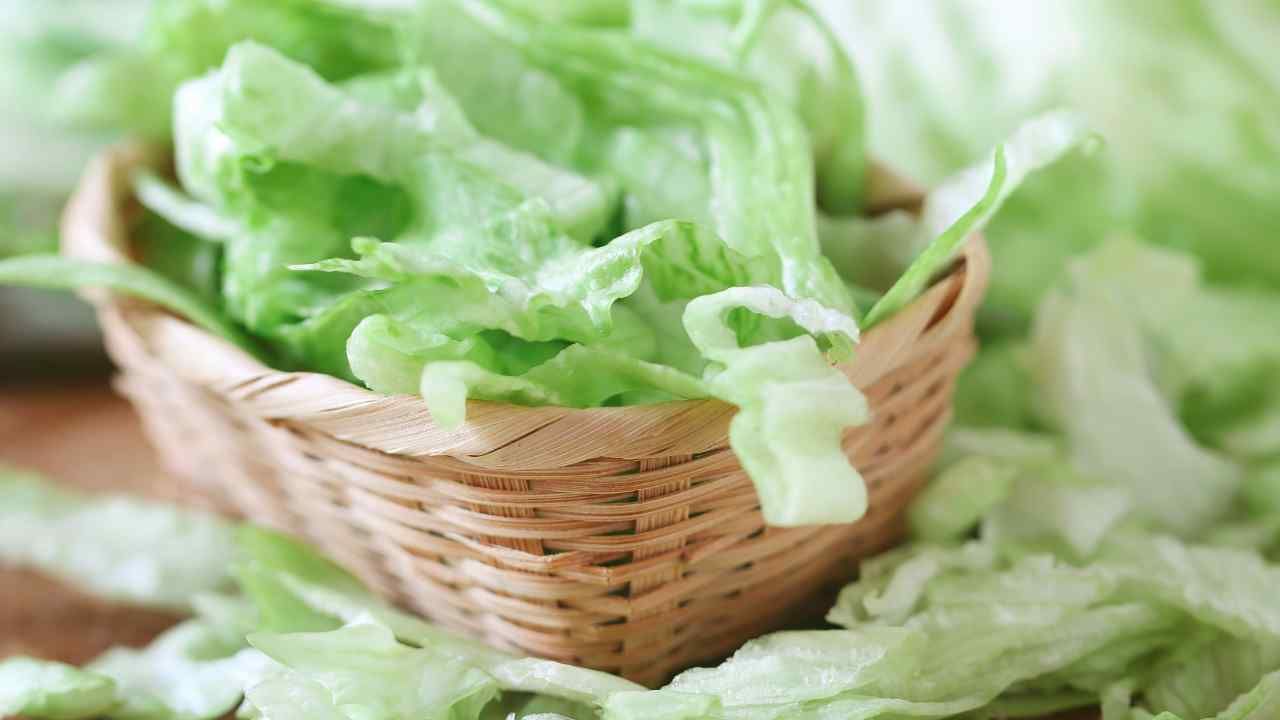
When you hear the words, “iceberg lettuce,” what comes to mind?
Does it make you think of salad, a hamburger topping, an essential part of Taco Tuesday? And also, would you consider it a healthy food?
For as long as I can remember, I’ve always heard people say, “Iceberg lettuce has no nutritional value.” So, being the health-conscious girl that I am, I used to never buy it. I would snub my nose at it, walking past it at the supermarket as I headed for things like kale and arugula.
There was one small problem though. For me, kale is okay, but I don’t really love the way it tastes, and I feel like it’s kind of a high-maintenance leaf.
You usually have to either cook it or at least massage it. I confess that on several occasions in the past I felt my life slowly slipping away from me as I stood in my kitchen, wrist-deep in a giant bowl of kale and olive oil, slowly kneading and massaging for what seemed liked forever.
By the time I had gotten the kale to the point of being palatable, I also usually needed a massage!
Meanwhile arugula or other dark leafy greens, well, I just don’t like them that much. It’s just a matter of taste for me. Yet, I’d always heard that you should focus on dark leafy greens and so I would make salads from them or put them in sandwiches, but, I can’t really say that I love them.
If you do prefer dark leafy greens to lettuces like iceberg, you might not really be that interested in this episode, so skip it and I’ll see you in the next one. That goes for any of my peeps on the carnivore diet too. I love ya, but for you, nothing to see here.
However, if you happen to be like me, a big fan of iceberg lettuce, but you’ve been avoiding buying it at the grocery store because everyone always says it has no nutritional value, then stick around as we’re going to get into it.
I’ll be talking about the nutrient content of iceberg lettuce, how to maximize vitamin absorption when eating it, and why I think it can make a great additional to your vegetable drawer.
So, hi! This is Julie from Julie Saad Wellness, holistic weight loss coaching.
So, iceberg lettuce. How do I love thee? Let me count the ways. For me it’s refreshing, crunchy, and goes with so many different things. On most days I eat either a half a head or a whole head of the stuff.
But as I said this is a recent thing for me, as, back in the day I shunned my favorite lettuce. Iceberg? Moi? Oh no, only the darkest of leaves for me! Which is kind of funny because at that time the rest of my diet really wasn’t so hot, but my leaf game was on point, or so I thought.
Today I was thinking about this and I wondered two things:
- Do other people love iceberg lettuce as much as I do?
- Did everyone else also grow up hearing that it had zero nutritional value or was that just me?
The People Have Spoken . . . Iceberg Lettuce Is Not in Vogue
So I decided to do a very quick, very non-scientific poll in a Reddit group to see what other people had to say about the subject.
Here are some of the responses I got about the way it tastes:
-It’s okay, but boring.
-I prefer romaine.
-I hardly consider it a food. It’s essentially crunchy water.
-It’s an excellent food.
Well, according to my very small sample, not everyone thinks it’s the most delicious leaf out there. I must harden my heart in the name of science and not let that get me down.
But the responses I got in terms of whether or not people considered it a healthy food were more in line with my expectations. People said things like:
-I’ve definitely heard it has less nutritional value. Not sure if it’s actually true.
-It’s like low level lettuce lol.
-It has zero nutritional value. . . I wouldn’t count it as a healthy green vegetable.
-Yeah, there is definitely nothing nutritional about it but there is nothing bad about it either.
-I wouldn’t consider it “healthy” as it has very little nutritional value.
-It’s good for you. (One person.)
So the majority of the answers I got to my question about whether or not iceberg lettuce was healthy stated that it had little or no nutritional value. In other words, my beloved iceberg has somehow managed to get a bad rap.
And it’s not just in my little survey, either. I had a look at the menu for Sweetgreen just now. If you’re not familiar with it, it’s a restaurant chain with 159 locations in the U.S., and they bill themselves as focused on healthy foods.
There was not a leaf of iceberg lettuce anywhere to be found on the menu. It’s all arugula, cabbage, Brussels sprouts, and romaine.
Hmm, what about restaurants that aren’t necessarily focusing on presenting themselves as healthy, like, McDonald’s? Well, turns out they’re still using iceberg lettuce on their burgers, but, to my surprise, several years back, they completely stopped using it in their salads, opting instead for a mix of baby kale, baby romaine, and a Tuscan blend.
McDonald’s stated that their customers had been complaining that the salads weren’t healthy enough. So the company responded to the change and 86ed the iceberg.
One of McDonald’s suppliers is a company called Ready Pac Foods. Their vice president of marketing at the time of the leaf overhaul, Ali Leon, stated plainly that iceberg lettuce had no real nutritional content.
Meanwhile another fast food chain, Chick-fil-A, is on the same page. They have completely banned iceberg lettuce from their kitchens. David Farmer, who currently serves as the VP of restaurant experience for the chain, had this to say about the change:
“It’s at the bottom of the salad food chain. There is no nutritional value in iceberg lettuce.”
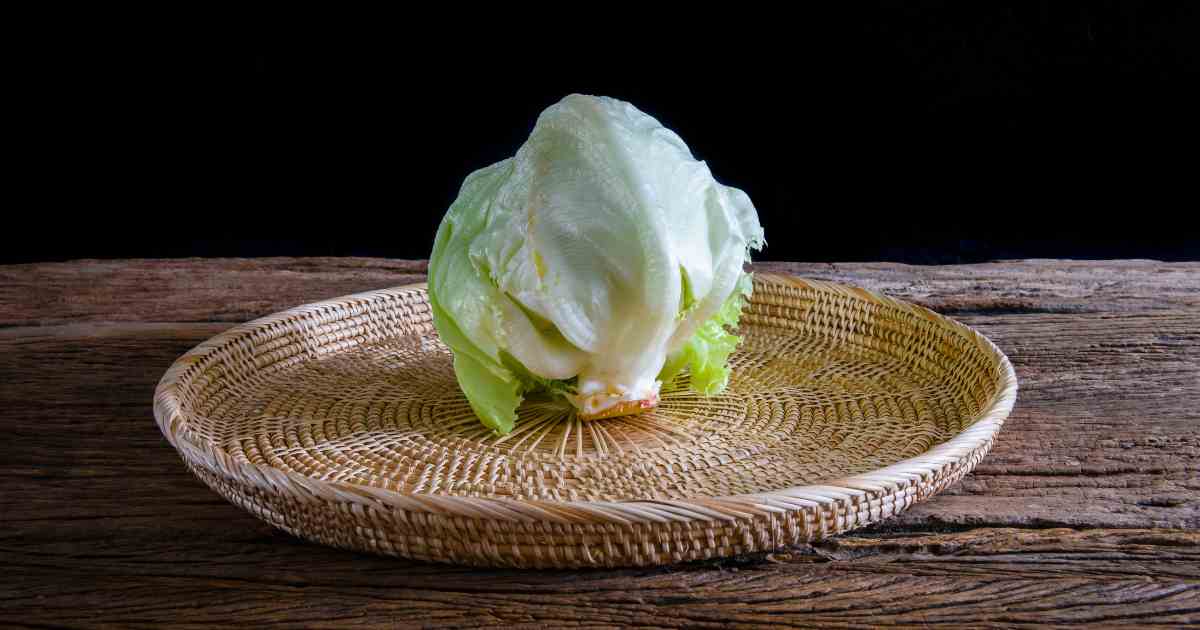
Wherever you turn, it seems that there is no love for iceberg lettuce.
So . . . is it true? Does iceberg lettuce really have no nutritional value?
Of course you know we’re going to look at the numbers.
Iceberg Lettuce's Nutritional Content
In iceberg lettuce, there are actually a few vitamins and minerals in there. The most notable being vitamin K1. This vitamin is an essential one and its best known function is to help in the process of blood clotting.
Vitamin K1 deficiency is pretty rare in healthy adults, but the American Academy of Pediatrics does recommend that all newborns receive a vitamin K1 injection within six hours of birth, as babies are born with very small amounts of vitamin K stored in their bodies and are therefore susceptible to something called vitamin K deficiency bleeding, which is exactly what it sounds like and is very serious.
So in one cup of iceberg lettuce, there are about 14 micrograms of vitamin K. For women, that works out to around 16% of your recommended daily intake which is 90 micrograms, while for men that works out to around 12% of the 120 micrograms you need per day. Not too shabby, in my opinion, especially if you’re having two or three cups of the stuff.
Looking at the other vitamins and minerals in iceberg lettuce is, admittedly, underwhelming. It has a little bit of vitamin A, a bit of folate (aka folic acid or vitamin B9), and some potassium, as well as small amounts of a few other essential nutrients but nothing to write home about.
So next let’s compare three types of greens to see who comes out on top in the nutrition war: chopped iceberg lettuce, kale, and arugula.
I compared one cup of each, again using data from the USDA.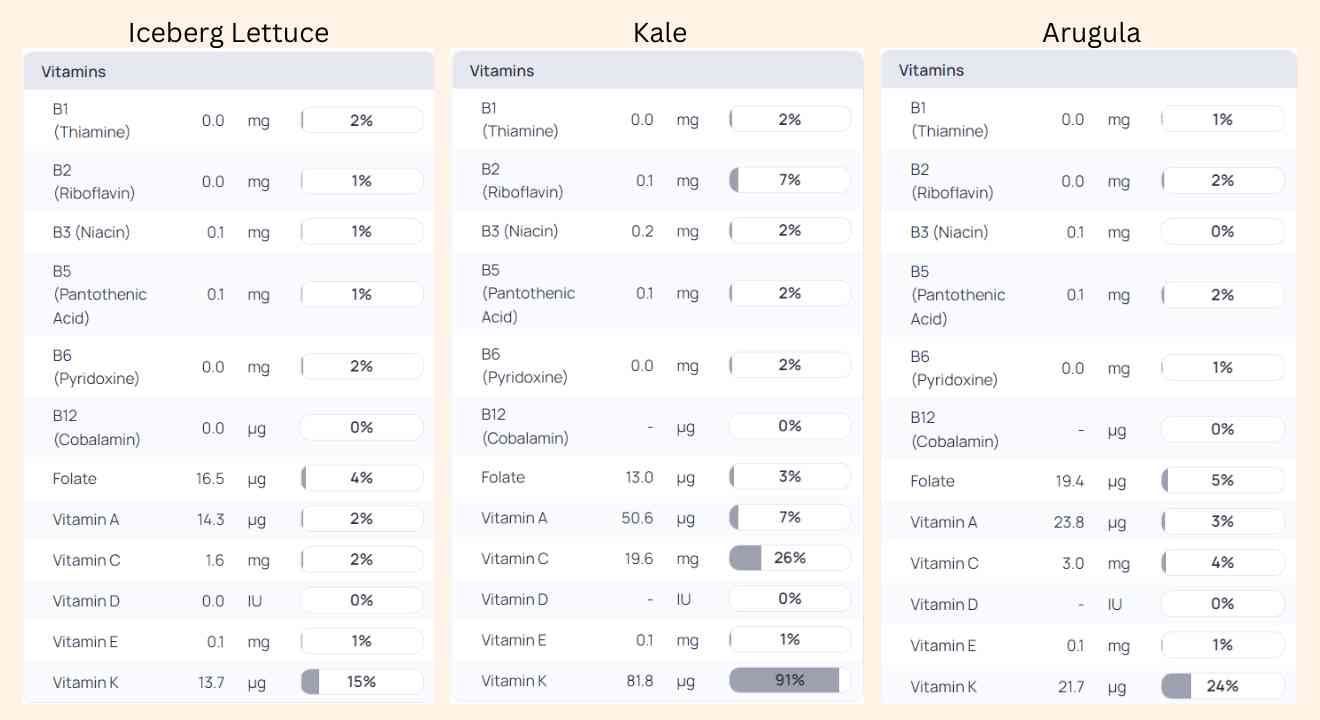
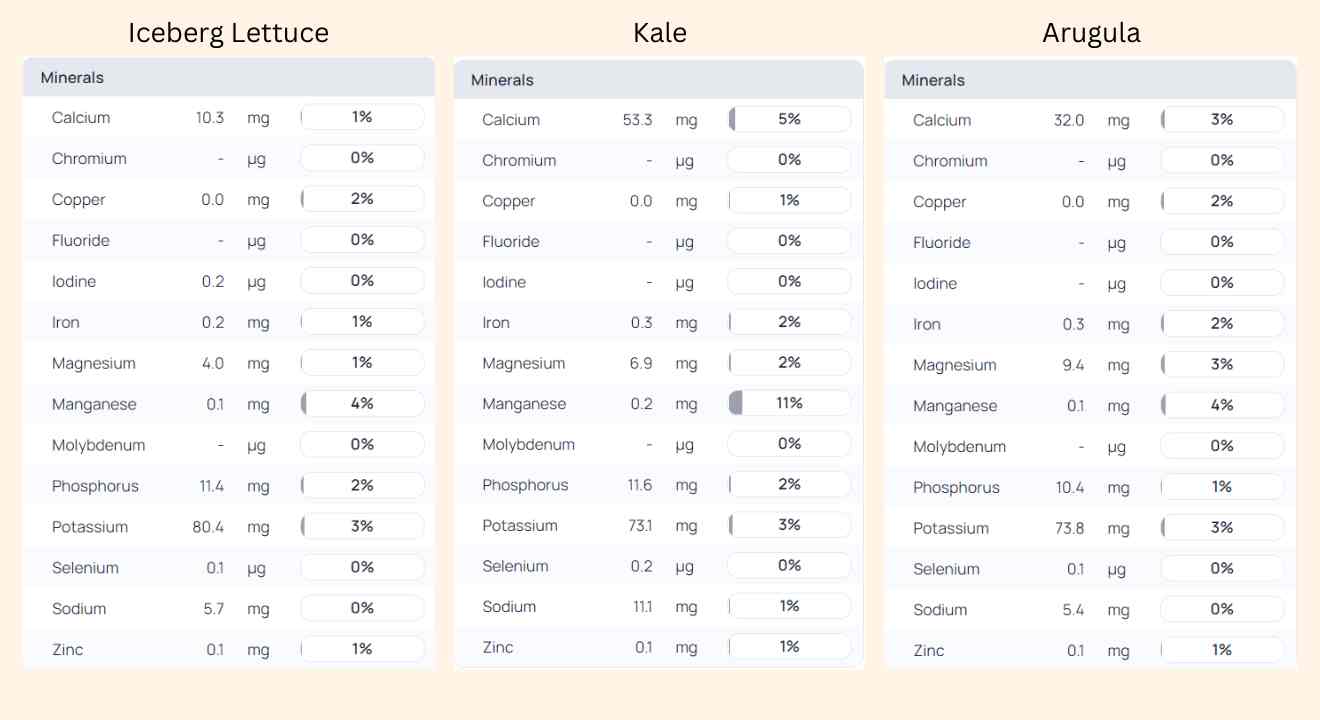
(The recommended daily values are from my diary and may be different for you.)
Starting with vitamin K, we can safely say that kale blows iceberg lettuce out of the water, having nearly ten times as much, cup for cup. Arugula also has nearly three times as much vitamin K as iceberg lettuce when compared by volume.
When we look at vitamin A, kale has around six times as much as iceberg lettuce does, while arugula has nearly three times as much.
For folate, it’s a similar story, with kale coming in at around three times as much folate as iceberg lettuce and arugula coming in at just over twice as much.
Iceberg lettuce does win the fight when it comes to potassium, but only by a nose, having just around 10% more than kale or arugula.
So, relatively speaking, yes, iceberg lettuce does have fewer nutrients overall than some of the other leafy greens out there. Yet I wouldn’t say it has no nutritional value at all.
Now, no matter which leafy green you’re a fan of, they do have one thing in common, which is a pretty low fat content. In the context of some vitamins, this can cause a problem when it comes to absorption.
You have probably already heard that there are water-soluble vitamins and fat-soluble vitamins. Vitamins A and K that we just talked about are both examples of the four fat-soluble vitamins in the human diet. The other two are vitamins D and E. These types of vitamins are better absorbed by our bodies when ingested with fat.
So remember all that fat-free salad dressing we used to buy in the 80s and 90s? Remember how it was marketed as super healthy? Hopefully you know by now that that was some serious BS for multiple reasons, but one of the reasons is that if your meal has little or no fat in it, fewer of the vitamins in your food are going to be taken up by your body.
So put some oil on your greens please and thank you, or at least eat them alongside something that has some fat in it, like an avocado or some bacon - I just made myself super hungry saying that - so that you can get more of the nutrients from your food.
In addition to some vitamins and minerals, one thing that’s clear to see about iceberg lettuce is that it contains a lot of water. So it can be a great way to sneak some extra hydration into your day if you haven’t gotten around to drinking that much, and can be a refreshing choice on a hot afternoon.
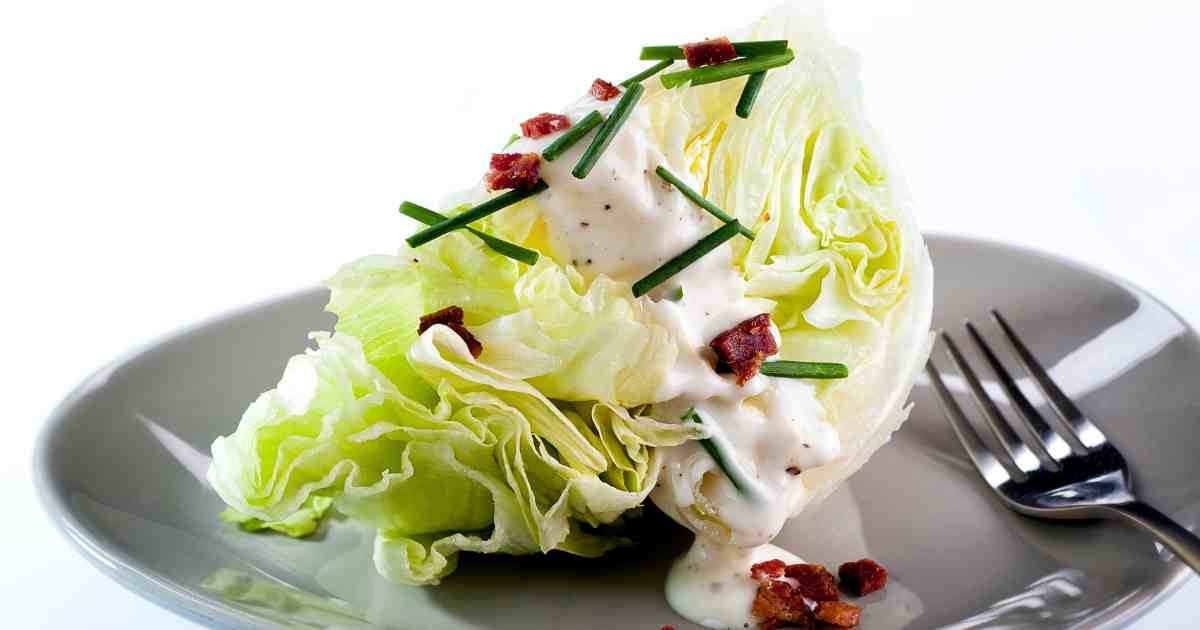
Another plus side to iceberg lettuce is its low fiber content. Yes, I said, “low.” I know some of you just heard that and are out there going, “This lady is crazy. We’re supposed to eat all the fiber. Fiber on everything! Waitress, bring me my chalice of Metamucil and disconnect the internet at once. I will hear no more of this rubbish.” Bear with me please.
In the future I’m going to go more into depth about the topic of fiber and whether or not people in general really need to be trying to get more of it in our diets the way nearly everyone and their mom recommends.
But for now, let’s just focus on one specific group of people. Some people with digestive issues such as IBS (irritable bowel syndrome) can have a hard time digesting some of the more fibrous leafy greens and can suffer because of this. So many of these folks may find that they tolerate iceberg lettuce quite well.
Okay, so that’s the nutrition side. I know I didn’t make the strongest case for iceberg lettuce on that front, but there are a few other reasons why I think it can be a valuable addition to your diet, if it’s something that fits with your desired style of eating and you like it, of course.
Good Things About Iceberg Lettuce
For one thing, it tends to be the least expensive leafy green at the supermarket. Of course this depends on when and where you buy it, but that’s definitely a plus in my book.
Also, in my experience, it doesn’t seem to go bad as quickly as some of the more delicate greens. I don’t know if I’ve just had bad luck or what, but nearly every time I buy something like arugula or baby spinach, I have to remember to use it pretty quickly or else it turns to mush. Gross.
Another advantage of iceberg lettuce is that its mild taste gives it a higher probability of being eaten by a very young person, so if you’re cooking for kids you might have better luck serving them iceberg lettuce than one of the darker, more bitter greens.
Well, all this talk of food has definitely awakened my appetite, so I’m going to go throw some bacon on the skillet, and have that along with some hard-boiled eggs and, you guessed it, a salad with iceberg lettuce. It’s my go-to vegetable. I usually have a pretty ridiculously-sized plate of it with some herbs from my garden, a generous amount of salt, pepper, a bunch of hemp seeds, apple cider vinegar and lots of olive oil. Since I eat a ketogenic diet and therefore get most of my energy from fat, I’m a big fan of being liberal with the oil on my salad and find it an easy way to get more fat into my diet and I love that I never leave the table hungry.
So, bon appetit to me and to you, whenever you next eat.
I hope you have enjoyed this little ode to my favorite leaves.
If you know anyone who would find this information useful, please share it with them.
Subscribe to this podcast to hear more about nutrition, achieving and maintaining your ideal weight, and all things related to wellness.
Thanks so much for being here, and have a happy and healthy day.

